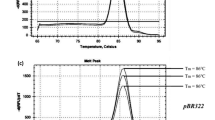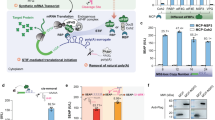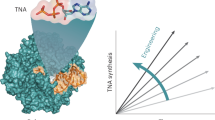Abstract
A TANDEM repeat of the sequence Ser-Pro-Thr-Ser-Pro-Ser-Tyr has been found at the C terminus in the largest subunit of RNA polymerase II (refs 1–5) with, for example, 26 units in yeast2 and 52 in mammals3,5. By removal of this 'tail', it has been shown that 11–23 units are necessary for the normal functioning of the poly-merase4,5. The functional role of the repeat is however, unclear, although it has been proposed that it binds to transcription factors6. As discussed in an earlier paper7, the repeat unit contains two Ser-Pro sequences which seem to be related to a DNA-binding unit found in histones, Ser-Pro-Lys-Lys8, and to the Ser-Pro-X-X motif which is often found in gene regulatory proteins and which, it has been proposed, is also a DNA-binding unit7. Here, I show that the repeat does indeed bind DNA and present evidence that it does so by the intercalation of tyrosine residues. These experi-ments involved synthetic peptides containing one or two repeat units. As the sequence Ser-Pro-X-X (where X represents any amino acid) has a strong tendency to assume a special β-turn7, a model of the unit composed of two such β-turns was made and compared with the structure of the drug Triostin A which is known to intercalate into DNA9,10. Two tyrosine side chains of the repeat overlap well with two quinoxaline rings of the drug and therefore, the model can provide a good explanation of the experimental results.
This is a preview of subscription content, access via your institution
Access options
Subscribe to this journal
Receive 51 print issues and online access
$199.00 per year
only $3.90 per issue
Buy this article
- Purchase on SpringerLink
- Instant access to full article PDF
Prices may be subject to local taxes which are calculated during checkout
Similar content being viewed by others
References
Corden, J. L., Cadena, D. L., Ahearn, J. M. & Dahmus, M. E. Proc. natn. Acad. Sci. U.S.A. 82, 7934–7938 (1985).
Allison, L. A., Moyle, M., Shales, M. & Ingles, C. J. Cell 42, 599–610 (1985).
Ahearn, J. M., Bartolomei, M. S., West, M. L., Cisek, L. J. & Corden, J. L. J. biol. Chem. 262, 10695–10705 (1986).
Zehring, W. A., Lee, J. M., Weeks, J. R., Jokerst, R. S. & Greenleaf, A. L. Proc. natn. Acad. Sci. U.S.A. 85, 3698–3702 (1988).
Allison, L. A., Wong, J.K.-C., Fitzpatrick, V. D., Moyle, M. & Ingles, C. J. molec. Cell Biol. 8, 321–329 (1988).
Sigler, P. B. Nature 333, 210–212 (1988).
Suzuki, M. J. molec. Biol. 207, 61–84 (1989).
Suzuki, M. EMBO. J. 8, 797–804 (1989).
Wang, A.H.-J. et al. Science 225, 1115–1121 (1984).
Quigley, G. J. et al. Science 232, 1255–1258 (1986).
Crawford, L. V. & Waring, M. J. J. molec. Biol. 25, 23–30 (1967).
Waring, M. J. J. molec. Biol. 54, 247–279 (1970).
Waring, M. J. & Wakelin, L. P. G. Nature 252, 653–657 (1974).
Wakelin, L. P. G. & Waring, M. J. Biochem. J. 150, 721–740 (1976).
Lee, J. S. & Waring, M. J. Biochem. J. 173, 129–144 (1978).
Lee, J. S. & Waring, M. J. Biochem. J. 173, 115–128 (1978).
Hélène, C., Monttenay-Garestier, T., & Dimicoli, J.-L. Biochim. biophys. Acta 154, 349–365 (1970).
Hélène, C. Nature New Biol. 234, 120–121 (1971).
McGhee, J. D. & von Hippel, P. J. molec. Biol. 86, 469–489 (1974).
McGhee, J. D. & von Hippel, P. J. molec. Biol. 103, 679 (1976).
Laugǎa, P., Markovitz, J., Delbarre, A., LePec, J.-B. & Roques, B. P. Proc. natn. Acad. Sci. U.S.A. 24, 5567–5575 (1985).
Wilmot, C. M. & Thornton, J. M. J. molec. Biol. 203, 221–232 (1988).
Dreyfuss, G., Swanson, M. S. & Rinol-Roma, S. Trends Biochem. Sci. 13, 86–91 (1988).
Alberts, B., Frey, L., & Delius, H. J. J. molec. Biol. 68, 139–152 (1972).
Bartholomew, B., Dahmus, M. E. & Meares, C. F. J. biol. Chem. 261, 14226–14231 (1986).
Allison, L. A. & Ingeles, C. J. Proc. natn. Acad. Sci. U.S.A. 86, 2749–2798 (1989).
Wang, A.H.-J., Ughetto, G., Quigley, G. J. & Rich, A. J. biomolec. Struct. Dynamics 4, 319–342 (1972).
Churchill, M. E. A. & Suzuki, M. EMBO J. 8, 4189–4195 (1990).
Author information
Authors and Affiliations
Rights and permissions
About this article
Cite this article
Suzuki, M. The heptad repeat in the largest subunit of RNA polymerase II binds by intercalating into DNA. Nature 344, 562–565 (1990). https://doi.org/10.1038/344562a0
Received:
Accepted:
Issue date:
DOI: https://doi.org/10.1038/344562a0
This article is cited by
-
Peptides with anticancer use or potential
Amino Acids (2003)
-
Regulation of TFIIH ATPase and kinase activities by TFIIE during active initiation complex formation
Nature (1994)
-
Gene fusion with an ETS DNA-binding domain caused by chromosome translocation in human tumours
Nature (1992)
-
RNA polymerase II C-terminal repeat influences response to transcriptional enhancer signals
Nature (1990)



